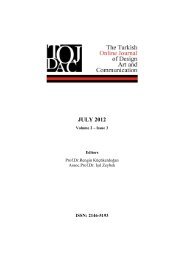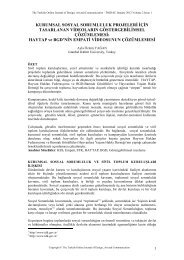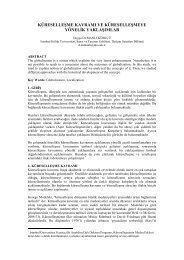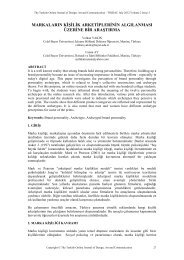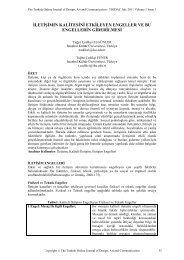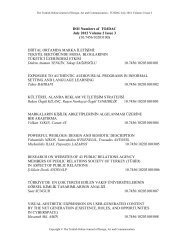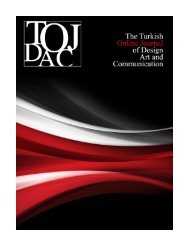aprıl 2012 - tojdac.org
aprıl 2012 - tojdac.org
aprıl 2012 - tojdac.org
You also want an ePaper? Increase the reach of your titles
YUMPU automatically turns print PDFs into web optimized ePapers that Google loves.
The Turkish Online Journal of Design, Art and Communication - TOJDAC April <strong>2012</strong> Volume 2 Issue 2<br />
In that setting of changes in the formal structure of the visual arts, the impact of the<br />
happenings, performances, events, actions, videos, among others, surpassed the simple<br />
repertoire, affirming themselves as a language that permits to the artist expresses his interior<br />
world and the things that surrounded him/her.<br />
Upon breaking the barriers and traditional limits, visual arts approached science, penetrating<br />
in diverse areas of the human knowledge, including the utilization of the machine as visual<br />
support - the technological art -, esthetics considered like one of the most expressive<br />
inventions in the history of the art.<br />
According to Roy Ascott, in his essay called Is There Love in the Telematic Embrace (apud<br />
Stiles, Selz, 1990, p. 491-492) the art in 1980 has been considered one as the most powerful<br />
computer technology, with video performances, video installations, etc.<br />
Ascott also comments that this new approaches has influenced in human behavior, both in<br />
society as in his private life, and it has leading researches to question what is to be human<br />
being, what is creativity, how do people think and perceive, and finally how do people relate<br />
to each other and with the planet as a whole.<br />
Since the advent of the first art video work, by Nam June Paik, in 1960, the artist was<br />
concerning with what Ascott described above, machine and man, as the following video<br />
makers, such and Bill Viola, has done ever since.<br />
David A. Ross, Director of the San Francisco Museum of Modern Art, San Francisco,<br />
California, EUA, in a catalog, “Bill Viola – a 25-year Survey” (1999) explains that many<br />
people want to know about the means by which the art and the new technologies interact. For<br />
Ross, although Viola works with video equipment installations and hi-tech highly<br />
sophisticated computer, his themes at the same time, is universal. He talks about life, death,<br />
fire, water, earth, etc. The simple beauty, the impact visceral to eternal spirituality in his<br />
work is based in a spiritual worthy assembly, which has influenced deeply and continues<br />
providing its Buddhist Zen development, the Christian mysticism, to optical physical and the<br />
mechanisms of the perception, the Islamic lyrical poetry Sufi. His art achieves the origins of<br />
the knowledge that resides inside his everyday routine. Ross ends his presentation about Bill<br />
Viola work with this phrase: “Wherever you are is the entry point” – Kabir (1440-1518).<br />
Although it dates from the 15th century, this phrase of Kabir is considered a contemporary<br />
concept in digital languages, mostly at the internet, as a person can be at many different<br />
places at the same time.<br />
However bringing this subject closer to the light of the Latin-American contemporary art, the<br />
authors Gerardo Mosquera and Mari Carmen Ramírez recognize that Identity in the context of<br />
globalization art scenery is a question conditioned to the legitimation, i.e., it must be<br />
understood in the configuration of new esthetics systems. For them, the circulation of the<br />
symbolic should be contained in an output as place of assertion of the supposed autonomy of<br />
the artistic field in order to be exercising their hegemonic power, transgressor of any<br />
dominant gesture. In "Beyond the Fantastic: Contemporary Art Criticism from Latin<br />
America", Gerardo Mosquera (1996) presents the global world as a paradox, a world of the<br />
difference.<br />
The Latin-American art still remain analyzed by many art critics to the light of diverse<br />
theories, where its culture is linking to illustrative and merely stereotypical narrative. One of<br />
the most harmful consequences of the colonization is how they call native cultures through<br />
the Europeans, i.e., it is the interpretation of complex mental and cultural structures under the<br />
diffuse light of the ethnic fantasies of the colonizer. There is a lack of information about the<br />
importance of Latin American artist in the contemporary international art scenery. Those who<br />
Copyright © The Turkish Online Journal of Design, Art and Communication 110



